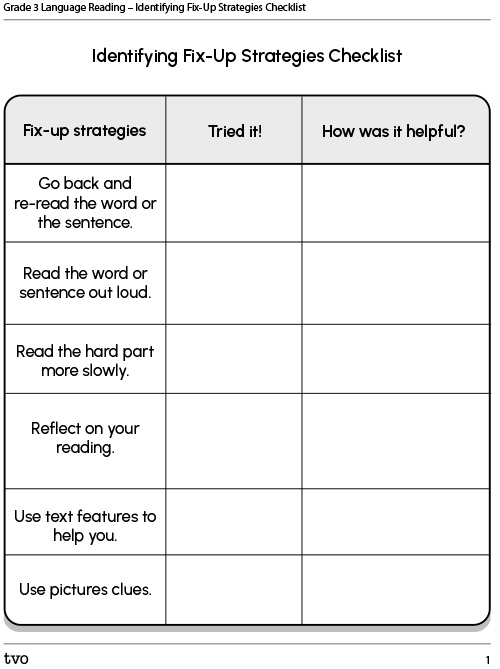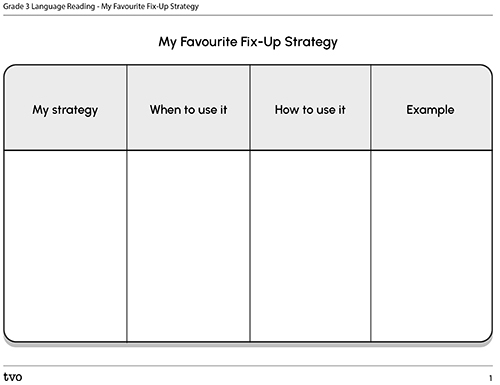Minds On
Monitoring our understanding

Brainstorm
Strategies
What are some strategies you use when you are trying to read or understand a new word?
Explore this video entitled “Reading and Reading Comprehension” to learn more about strategies. After the video, record any strategies you already use or any that are new to you.
Action
Commonly used fix-up strategies

Coming across unfamiliar words happens to all readers. When we read, it is important to make sure we understand what we are reading. The strategies we use to help understand unfamiliar words and help with understanding a new text are ‘Fix-Up Strategies.’
Examine the chart and identify the strategies you have used to fix your reading.
Complete the Fix-Up Strategies Chart in your notebook or using the following fillable and printable document.
| Fix-up strategies | Have I used this strategy? |
|---|---|
| Go back and re-read the word or the sentence. | |
| Read the word or sentence out loud. | |
| Read more slowly. | |
| Reflect - Did my first read through make sense? Is there something missing? Do I understand what I read? | |
| Use text features to help you. | |
| Use pictures clues. | |
| Break the word into chunks. | |
| Find parts of the word that you know. | |
| Identify patterns – does the word resemble another word that you know? | |
| Notice the first letter of the word. | |
| Skip the word and consider for more information. | |
| Ask someone for help. |
Press the ‘Activity’ button to access the Fix-Up Strategies Chart.
Task 1: Identifying fix-up strategies
Complete the Identifying Fix-Up Strategies Checklist in your notebook or using the following fillable and printable documents.
Identifying Fix-Up Strategies Checklist
| Fix-up strategies | Tried it! | How was it helpful? |
|---|---|---|
| Go back and re-read the word or the sentence. | ||
| Read the word or sentence out loud. | ||
| Read the hard part more slowly. | ||
| Reflect on your reading. | ||
| Use text features to help you. | ||
| Use pictures clues. | ||
| Break the word into chunks. | ||
| Find parts of the word that you know. | ||
| Ask someone for help. | ||
| Identify the first letter of the word. | ||
| Skip the word and look for more information. | ||
| Identify patterns – does the word resemble another word that you know? |

Press the Activity button to access the Identifying Fix-Up Strategies Checklist.
Activity (Open PDF in a new tab)Consolidation
Fix-up strategy mini-activity
Sharing our favourite fix-up strategies with other readers helps you and others improve your reading skills. Teacher Winny shares her challenge for learning new words in the following video. How does she share her strategy?
Mini-activity: favourite strategy

Create a mini activity to teach a friend how to use one of your favourite fix-up strategies discussed in the activity or one that you used that was not on the list. Feel free to be creative in how you present your activity.
Here are some suggestions:
- create a bookmark
- record a video
- create a poster
- role-play using the strategy
Be sure to answer the questions below in your mini activity:
- What is this strategy?
- When would you use it?
- Why is this your favourite fix-up strategy?
- What makes your fix-up strategy unique?
- Show an example of how to use your strategy.
Complete the My Favourite Fix-Up Strategy in your notebook or using the following fillable and printable documents.
| My strategy: | When to use it: | How to use it: | Example: |
|---|---|---|---|

Press the Activity button to access the My Favourite Fix-Up Strategy.
Activity (Open PDF in a new tab)Think about your learning

Were there any strategies that you have not used before?
Choose two of these strategies that you have not used. For each strategy, explain how you could use it in the future to help you understand a new word. Be ready to share these new strategies and your plan!
Complete the Strategy Reflection Activity in your notebook or using the following fillable and printable document.
| Strategies I have not used. | How can I use it in the future to help me understand a new word? |
|---|---|
Press the ‘Activity’ button to access the Strategy Reflection Activity.
Reflection
How do you feel about what you have learned in this activity? Which of the next four sentences best matches how you are feeling about your learning? Press the button that is beside this sentence.
I feel...
Now, record your ideas about your feelings using a voice recorder, speech-to-text, or writing tool.